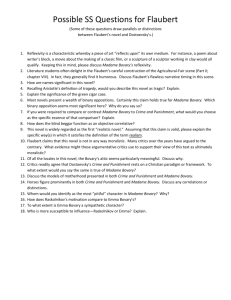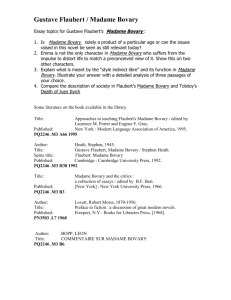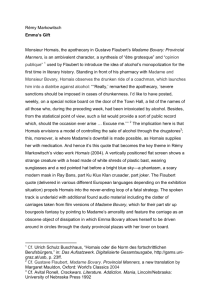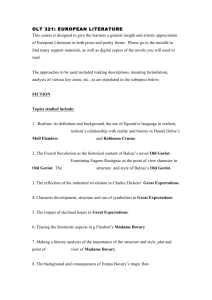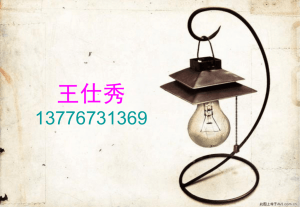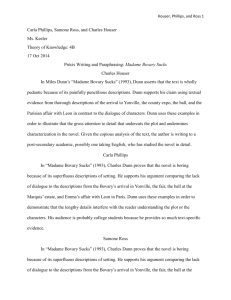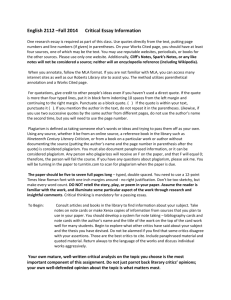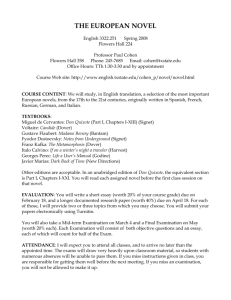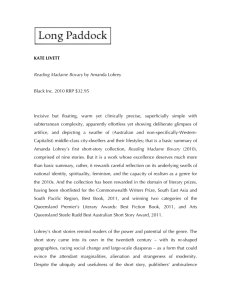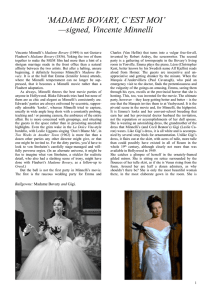PDF (Halaman Depan)
advertisement
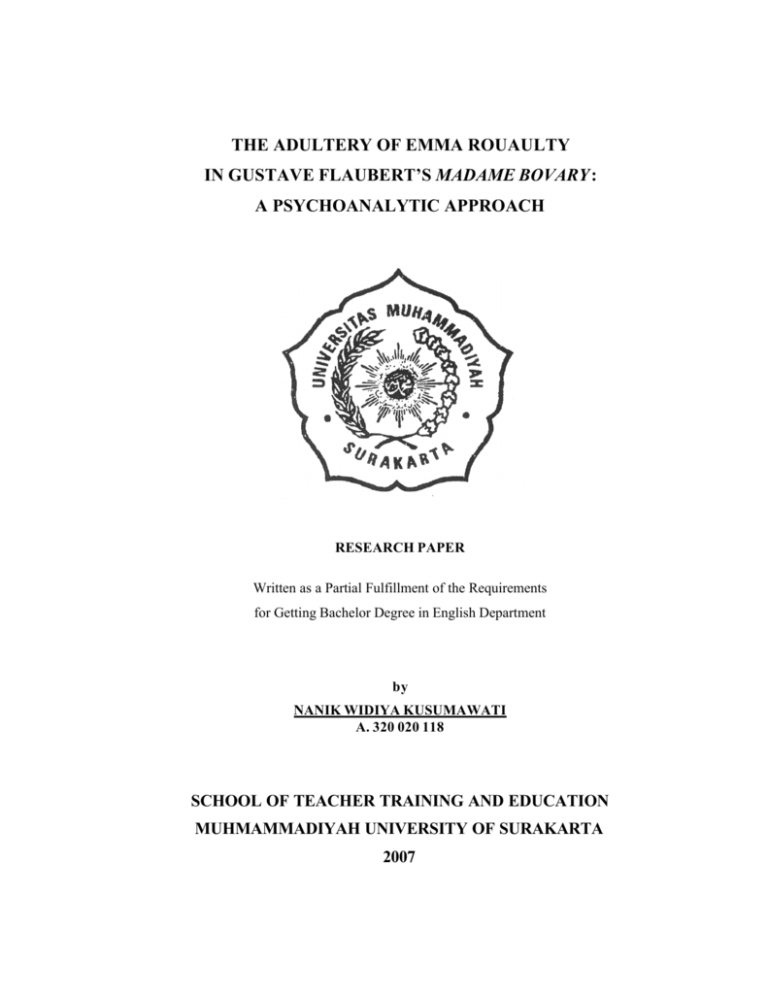
THE ADULTERY OF EMMA ROUAULTY IN GUSTAVE FLAUBERT’S MADAME BOVARY : A PSYCHOANALYTIC APPROACH RESEARCH PAPER Written as a Partial Fulfillment of the Requirements for Getting Bachelor Degree in English Department by NANIK WIDIYA KUSUMAWATI A. 320 020 118 SCHOOL OF TEACHER TRAINING AND EDUCATION MUHMAMMADIYAH UNIVERSITY OF SURAKARTA 2007 THE ADULTERY OF EMMA ROUAULT IN GUSTAVE FLAUBERT’S MADAME BOVARY : A PSYCHOANALYTIC APPROACH by : NANIK WIDIYA KUSUMAWATI A. 320 020 118 Approved to be Examined By consultant team: Consultant I Consultant II (Drs. H. Abdillah Nugroho, M.Hum.) (Aryati Prasetyarini, S.Pd.) ii ACCEPTANCE THE ADULTERY OF EMMA ROUAULT IN GUSTAVE FLAUBERT’S MADAME BOVARY : A PSYCHOANALYTIC APPROACH By: NANIK WIDIYA KUSUMAWATI A. 320 020 118 Accepted and Approved by the Board of Examiners School of Teacher Training and Education Muhammadiyah University of Surakarta Team of Examiners: 1. Drs. Abdillah Nugroho, M.Hum. (Examiner I) ( ) 2. Aryati Prasetyarini, S.Pd. (Examiner I) ( ) 3. Drs. M. Thoyibi, MS. (Examiner I) ( ) Dean, Drs. H. Sofyan Anif, M.Si. NIK. 547 iii SUMMARY NANIK WIDIYA KUSUMAWATI. A 320 020 118. THE ADULTERY OF EMMA ROUAULT IN GUSTAVE FLAUBERT’S MADAME BOVARY MUHAMMADIYAH UNIVERSITY OF SURAKARTA, RESEARCH PAPER 2006. The study aims at finding the motives that encourage Emma, the major character, to commit adultery in Gustave Flaubert’s Madame Bovary. The object of research is the novel entitled Madame Bovary, by Gustave Flaubert. The researchers uses Psychoanalytic approach focusing on Sigmund Freud’s psychoanalytic theory of motivation in analyzing the adultery of Emma Renault. Therefore, the study analyses the novel in terms of its structural elements and based on psychoanalytic theory. The study belongs to a qualitative study in which the writer uses two data sources. The primary data source is the novel Madame Bovary itself , meanwhile the secondary one is any literature related to the study. From the result of analysis, it can be drawn some conclusion. Firstly, the structural elements of the novel present a good unity. It consists of exposition, complication, climax and resolution. Flaubert takes the theme that adultery is not good, we must learn to faithful with our couple. Secondly, it tells that Emma’s motivation of committing adultery is dealing with her disappointment to her marriage life. Being thirst for sexual satisfaction and love from romantic man forces her to commit adultery. iv MOTTO “Sesungguhnya sesudah kesulitan itu ada kemudahan, maka apabila kamu telah selesai (dari suatu urusan), kerjakanlah sunggu h-sungguh (urusan) yang lain dan hanya kepada Tuhanlah hendaknya kamu berharap” (QS. Al-insyiroh: 6 – 8) “Ingatlah, hanya dengan mengingat Allah hati menjadi tentram”. (QS. Ar-Ra’du (13): 28) “Cukuplah Allah menjadi penolong kami dan Dia adalah sebaik -baiknya pelindung”. (QS. Al-Imron: 173) “Tak seorangpun dapat menanamkan pelajaran kepadamu kecuali ia sendiri sudah terjaga difajar pengetahuanmu” (Kahlil Gibran) v DEDICATION This research paper is dedicated to: * My beloved father and mother for their prayer, love and support, * My lovely brother, Andrian Widi Setiyoko, for his support, * Someone who will be my husband “Fajar Sigit Prasetyo”, * All of my friends in English Department 2002 vi ACKNOWLEDGEMENT Assalamu’alaikum Wr. Wb. Praise to Allah SWT, the ALMIGHTY GOD, for blessing and guiding in completing this research paper as a partial fulfillment of requirement for Bachelor Degree in English Department. I realize that the research is impossible to be finished without the helps of other people. Therefore, in this opportunity I would like to express my special and deepest gratitude and appreciation to: 1. Drs. H. Sofyan Arif, M.Si, as the Dean of Teacher Training and Education Faculty. 2. Koesomo Ratih, S.Pd, M.Hum, as the Chief of English Department. 3. Drs. H. Abdillah Nugroho, H.Hum, as the first consultant for guidance, advice and correction from the beginning until the end of this research paper. 4. Aryati Prasetyarini, S.Pd, as the second consultant for guidance, advance and correction from the beginning until the end of this research paper. 5. All lecturers of English Department, who have shared and given their knowledge for me in mastering English. 6. For my Father and Mother who always pray everyday and everytime, only for my success and happiness and their support “I LOVE YOU”. 7. For my only brother, Andrian Widi Setiyoko, thank you for your guidance and support. vii 8. For someone who always accom panis me everyday “Fajar Sigit Prasetiyo”, thank you for your support, advice and “I LOVE YOU”. 9. For all my big family “Thank for all”. 10. To all my friend in “SAST”, Wahyu, Wati, Tia, Dini, Ari, Evi, Eni, Heni, and Juce. 11. All of my friends in English Department 2002, especially in C class. 12. People who have contributed greatly to the completion of this research paper, yet the writer can’t mention them entirely. Finally, I realize that this research is still for from being perfect. Therefore, suggestion and criticism will be accepted for the improvement of this research. Hopefully, this research paper will be useful for all readers to increase their knowledge about psychoanalytic. Wassalamu’alaikum Wr. Wb. Surakarta, NWK viii TABLE OF CONTENT Page TITLE ............................................................................................................. i APPROVAL .................................................................................................. ii LEGITIMATION ............................................................................................ iii SUMMARY .................................................................................................. iv MOTTO .......................................................................................................... v DEDICATION ................................................................................................ vi ACKNOWLEDGEMENT .............................................................................. vii TABLE OF CONTENT................................................................................... ix CHAPTER I : INTRODUCTION ................................................................... 1 A. Background of the Study .................................................... 1 B. Literary Review.................................................................. 5 C. Problem Statement ............................................................ 5 D. Limitation of the Study ..................................................... 5 E. Objective of the Study ....................................................... 5 F. Benefit of the Study ........................................................... 6 G. Research Method ............................................................... 6 H. Research Paper Organization ............................................ 7 CHAPTER II: UNDERLYING THEORY ..................................................... 8 B. Notion of Psychoanalysis .................................................. 8 1. Unconscious ................................................................ 9 2. Preconscious ................................................................. 9 3. Conscious .................................................................... 9 ix C. Theory of Personality ......................................................... 10 1. Id .................................................................................. 10 2. Ego................................................................................ 11 3. Superego....................................................................... 12 D. Adultery ............................................................................. 13 E. Theoretical Application...................................................... 14 CHAPTER III: THE STRUCTURAL ANALYSIS OF MADAME BOVARY 15 A. Structural Elements ............................................................ 15 1. Character and Characterization ................................... 15 2. Setting........................................................................... 24 3. Plot ............................................................................... 26 4. Point of View ................................................................ 28 5. Style ............................................................................. 29 B. Discussion .......................................................................... 31 CHAPTER IV: PSYCHOANALYTIC ANALYSIS ....................................... 34 A. Id ........................................................................................ 34 B. Ego .................................................................................... 36 C. Superego ............................................................................ 38 CHAPTER V : CONCLUSION AND SUGESTION ..................................... 41 A. Conclusion.......................................................................... 41 B. Suggestion ......................................................................... 42 BIBLIOGRAPHY APPENDIX x

